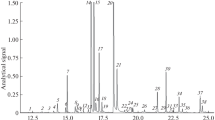Abstract
A new method of extracting essential oils from dried plant materials has been studied. By adding a microwave-absorption medium (MAM) to a reactor, solvent-free microwave extraction (SFME) was improved and can be used to extract essential oils from dried plant material without pretreatment. With a microwave irradiation power of 85 W it took only approximately 30 min to extract the essential oils completely. The whole extraction process is simple, rapid, and economical. Three types of MAM, iron carbonyl powder (ICP), graphite powder (GP), and activated carbon powder (ACP), and two types of dried plant material, Illicium verum Hook. f. and Zingiber officinale Rosc., were studied. The results were compared with those obtained by use of conventional SFME, microwave-assisted hydrodistillation (MAHD), and conventional hydrodistillation (HD), and the conclusion drawn was that improved SFME was a feasible means of extracting essential oils from dried plant materials, because there were few differences between the composition of the essential oils extracted by improved SFME and by the other methods.

Similar content being viewed by others
References
Ganeshjeevan R, Chandrasekar R, Sugumar P, Kadigachalam P, Radhakrishnan G (2005) J Chromatogr A 1069:275–280
Herbert P, Morais S, Paíga P, Alves A, Santos L (2006) Anal Bioanal Chem 384:810–816
Oriza T, Simone M, Paula P, Cristina D (2005) Anal Bioanal Chem 382:477–484
Lucchesi ME, Chemat F, Smadja J (2004) J Chromatogr A 1073:323–327
Lucchesi ME, Chemat F, Smadja J (2004) Flavour Frag 19:134–138
Wang ZM, Ding L, Li TC, Zhou X, Wang L, Zhang HQ (2006) J Chromatogr A 1102:11–17
Ruan SP, Xu BK, Suo H, Wu FQ, Xiang SQ, Zhao MY (2000) J Magn Magn Mater 212:175–177
How H, Vittoria C (1991) J Appl Phys 69:5138–5140
Walkiewicz JW, Kazonich G, McGill SL (1988) Miner Metall Process 5:39–42
Chemat F, Poux M (2001) Tetrahedron Lett 42:3693–3695
Pinho MS, Gregori ML, Nunes RCR, Soares BG (2001) Polym Degrad Stabil 73:1–5
Editorial Committee of Pharmacopoeia of People’s Republic of China (2005) Pharmacopoeia of People’s Republic of China. Chemical Industry Press, Beijing, China, pp 4
Rodrigues VM, Rosa PTV, Marques MOM, Petenate AJ, Meireles MAA (2003) J Agric Food Chem 51:1518–1523
Editorial Committee of Pharmacopoeia of People’s Republic of China (2005) Pharmacopoeia of People’s Republic of China. Chemical Industry Press, Beijing, China, pp 66
Wohlmuth H, Smith MK, Brooks LO, Myers SP, Leach DN (2006) J Agric Food Chem 54:1414–1419
Behera S, Nagarajan S, Rao LJM (2004) Food Chem 87:25–29
Charalambous G (1994) Spices, herbs and edible fungi. Elsevier Science, Amsterdam, The Netherlands
Editorial Committee of Pharmacopoeia of People’s Republic of China (2005) Pharmacopoeia of People’s Republic of China. Chemical Industry Press, Beijing, China, pp addenda 57–58
Cong PZ (1987) Applications of mass spectrum in nature organic chemistry. Science Press, Beijing, China, pp 595–645
He J, Sun BG (1995) The chemistry and technology of spices. Chemical Industry Press, Beijing, China, pp 32–42
Singh G, Maurya S, Catalan C, de Lampasona MP (2005) Flavour Fragr J 20:1–6
Author information
Authors and Affiliations
Corresponding author
Rights and permissions
About this article
Cite this article
Wang, Z., Wang, L., Li, T. et al. Rapid analysis of the essential oils from dried Illicium verum Hook. f. and Zingiber officinale Rosc. by improved solvent-free microwave extraction with three types of microwave-absorption medium. Anal Bioanal Chem 386, 1863–1868 (2006). https://doi.org/10.1007/s00216-006-0778-6
Received:
Revised:
Accepted:
Published:
Issue Date:
DOI: https://doi.org/10.1007/s00216-006-0778-6




